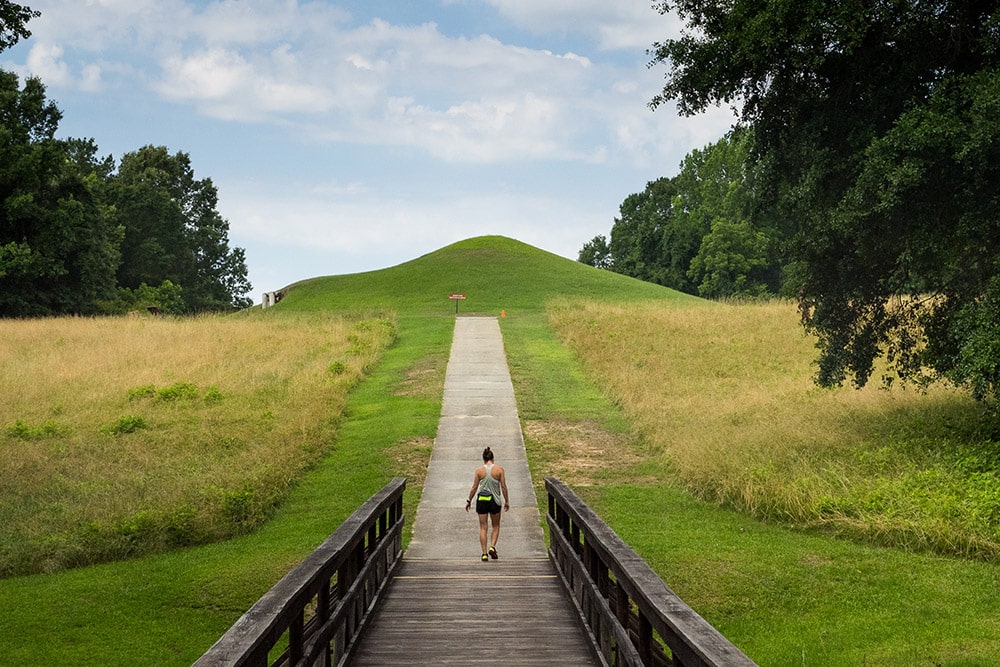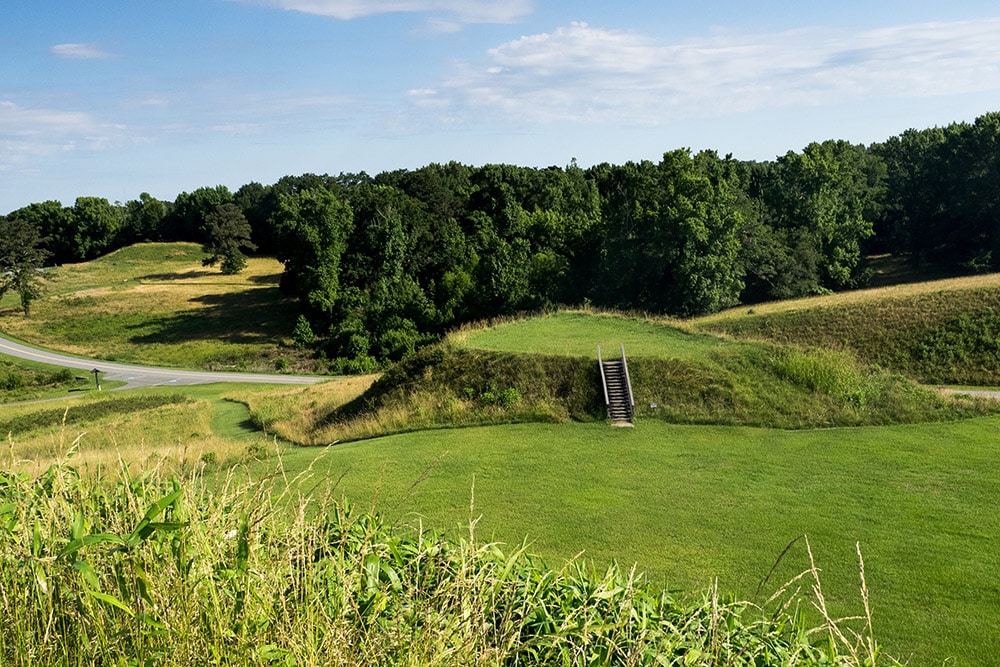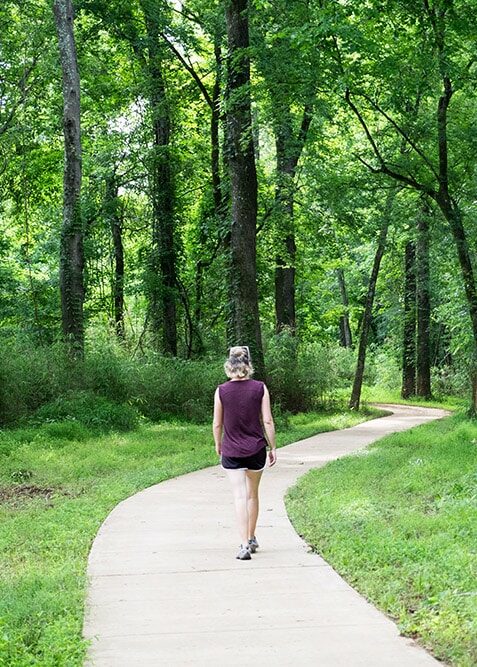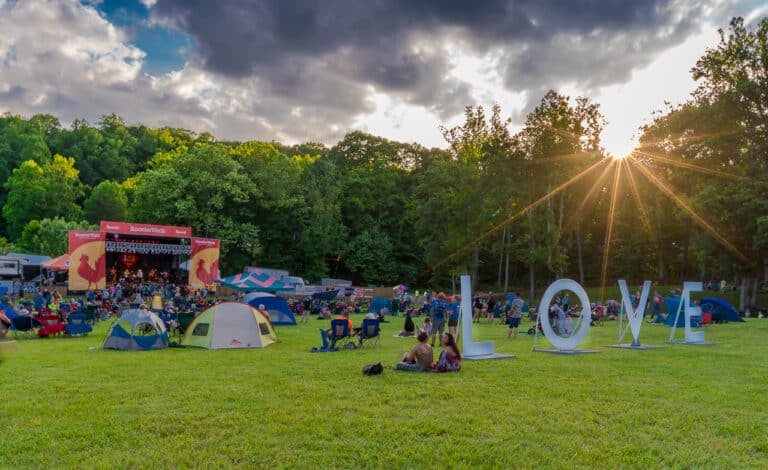A road-trip detour leads to new discoveries at Ocmulgee Mounds and nearby Macon

Recently my wife and I were driving across the South, searching for a quick stop on a cross-country road trip, when a small dot on the National Park System map caught my eye: Ocmulgee Mounds National Historical Park, just sitting by itself in the middle of Georgia. Displaying every National Park Service unit across the country, these overview maps are a great tool to have on a trip, and when you’re not familiar with a particular spot, sometimes you just have to roll the dice.
We pulled into the adjoining city of Macon on a Saturday afternoon in late May. Our first stop was the forested Amerson River Park—mostly because the name includes two of our favorite words. A quick internet search indicated there were several miles of walking paths. But figuring out this busy park was another matter. First, I parked in the wrong spot. Then we walked the wrong way and ended up emerging from pine trees into a high school graduation party. Most of the dads and sons were sweating in the shade of a pavilion, watching the overheated moms dance, while the giggling daughters pretended they were cool with it.
My wife and I returned to the forest. We soon found our way along the Park Loop trail, which roughly followed a protruding bend in the Ocmulgee River. In the water below, a pack of inner tubers floated lazily downstream past a sandy beach filled with locals. While exploring, we stumbled across a section of the partially completed Ocmulgee Heritage Trail, currently 13 miles and counting. When completed, this mixed-use paved path will run from Amerson River Park south along the river through town to Ocmulgee Mounds.
That evening, we faced a challenging situation. Staying in a city of over 150,000 people, about 30,000 of whom are students at five local colleges and universities, there were just too many breweries to choose from. My wife immediately nixed my suggestion to visit them all for “research” (around four plus several tap rooms). Instead, we picked one and took a leisurely drive through Macon’s historic downtown on our way over.
Fall Line Brewing Co. is housed in a refurbished brick warehouse, with an excellent outdoor area. The brewery is named for the Atlantic Seaboard Fall Line, which passes through Macon. This roughly 900-mile ridgeline marks the boundary between the rolling foothills of the Piedmont and the sandy coastal plain.
Sitting outside, I tried the hazy pale ale and an excellent brisket sandwich. My wife ordered the veggie sandwich and hoped for a cider but was pleasantly surprised by their cherry-lime sour. A rowdy wedding reception was happening in the brewery’s event hall which inspired me to next try the flagship IPA. We watched as increasingly sweaty and inebriated attendees spilled outside in formal attire, fervently postponing their inevitable dehydration with craft beer.
Early the next morning, we were the second vehicle in the parking lot at Ocmulgee Mounds National Historic Park. The visitor center wasn’t open yet, so we took off on a self-guided walking tour.
Sometime between 15,000 and 20,000 years ago, Paleo-Indians dispersed from Eurasia across the Bering land bridge into North America. By roughly 12,000 years ago, they were hunting and gathering throughout the region surrounding present-day Macon. About 1,100 years ago, the Mississippian culture had long been farming the river bottoms when they began building complex earthworks at Ocmulgee, including elevated ceremonial and burial mounds. But after 300 years, this thriving riverside community was mysteriously abandoned.
Centuries later, European explorers and American settlers would arrive and notice these lingering mounds. But it wasn’t until 1934 when the site was protected as a U.S. national monument and archeological excavations began. Today, the redesignated national historic park totals about 3,300 acres and offers eight miles of walking paths winding through seven preserved mounds.
Our first stop was Earth Lodge, where a recreated ceremonial chamber was built over an authentic clay floor discovered atop a surviving mound. Ducking through a log-framed passageway led inside the heart of this mound, where Mississippian tribespeople gathered a thousand
years ago.
We followed the path past Cornfield Mound and an old village site to the outline of a British trading post, established in 1690 to facilitate trade with the Muscogee. This tribe descended from the mound builders, and they inhabited the area until the 1830s when they were forcibly relocated by the U.S government along the Trail of Tears to Oklahoma.

Reaching the park road, we passed a couple walking a pair of bicycles. They were the first two of about 25 total visitors we would encounter that morning—at a park that sees only about 150,000 visitors per year.
We trudged on through the hot and humid morning toward the edge of Funeral Mound. This was once a burial ground for elite members of the Ocmulgee society, who built it up in successive stages over centuries.
Turning back along the road, my wife and I followed the bed of a former railroad that was built through the site in the 1840s, partially destroying what became known as Lesser Temple Mound. It’s the smaller of the two tallest mounds in the park, the other being the Great Temple Mound. We climbed the stairs to the 55-foot summit of this earthen structure, which offered expansive views of riparian forest and the building tops of downtown Macon. Archeologists estimate it took 10 million baskets of dirt, each weighing about 60 pounds, to build this flat-topped pyramid where the village chief may have lived.
From here we followed a round-about route through the remaining highlights. We crossed a bridge over Walnut Creek and walked down to the Ocmulgee River, where the River Trail joins the Heritage Trail. Then we backtracked and followed the Opelofa Trail through wetlands. A slight incline led up to Southeast Mound, the purpose of which has puzzled archeologists due to its location outside the village site’s fortifications.
Next came the twisty Bartram Trail, named for famed naturalist and explorer William Bartram, who visited what he called the Ocmulgee Old Fields in 1774. Near the visitor center, we detoured to some Civil War earthworks created during a pair of onsite battles fought in 1864 that related to Sherman’s March to the Sea.
Inside the visitor center, we circled through archeology exhibits that offered thousands of years of fascinating context for the site. We learned about nomadic hunters following roaming mammoth herds, the Mississippian peoples populating the Southeast, the Muscogee’s ancestors building the Ocmulgee Mounds, and the largest archeological dig in American history uncovering the remnants that became a national historic park.
As we drove out of town, we agreed that someday we’d return. But in the meantime, we pulled out the NPS System Map and pondered, where to next?
Cover Photo: By Mike Bezemek








